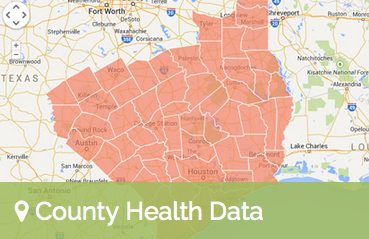From our newly-released Children’s Health Snapshots to adult obesity statistics to poverty rates, we’ve compiled a variety of important county-level information that helps tell the story of health in the 57 counties of the Episcopal Diocese of Texas. At first, some of the indicators may seem to have little to do with health or being sick. However, we know factors like premature births and children’s reading levels are indicators of the overall health and development of children and adults in a community. Where you live can influence how well you live.
Click on the map below to see health data for all 57 countiesThis data means little if we’re not called to action. Whether you’re a clinic, a non-profit organization or a congregation, there are many ways to put this county health data to work to help improve your community’s health. Here are three ideas:
Start a conversation
Whether it’s your county’s third-grade reading test scores or adult obesity rate, there are stories behind all the numbers. Why is this happening? What are some of the root causes of these health problems? You can use important questions to engage your community at the grass-roots level. Ask questions, share data, and convene groups to discuss specific concerns in your area.
“We hope people will use this information to look at the various indicators and find something that moves them to take action,” said Elena Marks, president and CEO of the Episcopal Health Foundation. “Look for the root causes with others and begin to talk about what would need to take place to change these numbers.”
Just starting the conversation about community health can prove to be a catalyst to discover what’s really causing problems and finding ways to address the root causes. A conversation shows we’re in this together as a community. And don’t hesitate to highlight the positives. What’s been done to improve these numbers? You can share what works well with other communities. The conversation should go both ways.
Create a sense of urgency
You can also use these indicators to demonstrate why certain concerns are important NOW. For example, we just added research about the health insurance “coverage gap” in Texas to our County Health Map. With incomes too high to qualify for Medicaid and too low to receive health insurance subsidies under the Affordable Care Act, Texans in the “coverage gap” are uninsured adults who can’t get affordable health insurance. Methodist Healthcare Ministries and the Center for Public Policy Priorities developed county-specific information to explain the benefits of closing this coverage gap by using available federal funding. The result – more than one million uninsured Texans would most likely gain coverage. As state lawmakers consider changes in Austin right now, this information is one example of the need to create a sense of urgency. In this case, it’s an urgent need to help improve access to quality health care for millions of Texans.
Other indicators like high child poverty rates and low reading scores show the urgent need to improve early childhood development. Urgency, backed by solid information, can help stimulate conversations and actions in new and effective ways.
Create and choose effective programs
All this information not only calls communities to action, but together with conversation and collaboration, the data can help spark innovative programs and ideas.
“It requires a wholesale collaborative effort that communities are sometime reluctant to take on,” Marks said. “But it really does take a large-scale effort.”
For clinics and non-profit organizations, it may help prompt collaboration with other groups serving the same populations. Certain indicators may serve as catalysts to establish pilot programs to test new ways of tackling the real cause of a health problem.
Churches may use the information to see their community in a new way. After reaching out to neighbors, congregations may come away with new ideas for local solutions to some of these health concerns. Then, they can put the power of parishioners to great use in helping communities.
For all of us, this county health data can help drive conversations, influence action, and help us recognize that it takes an informed community to transform community health.
